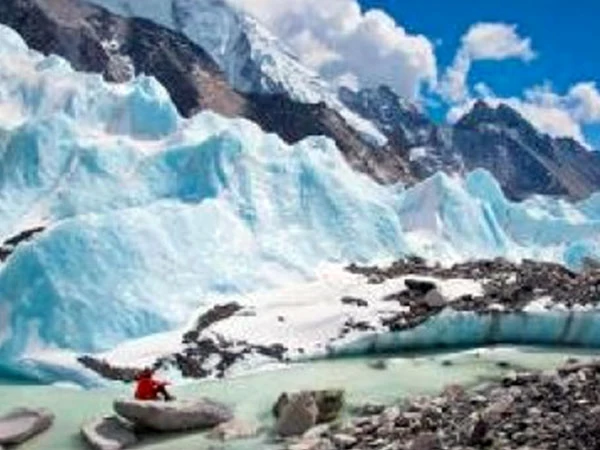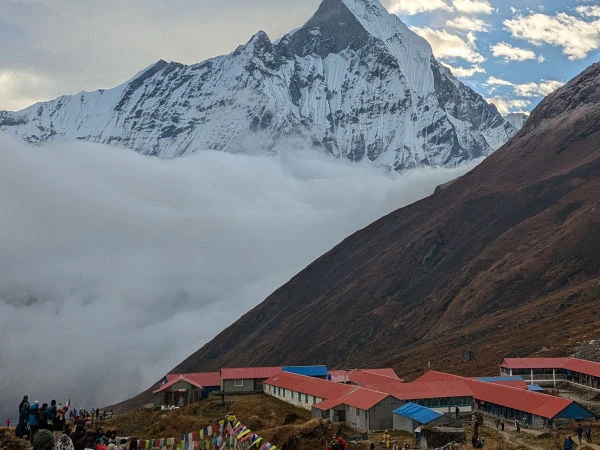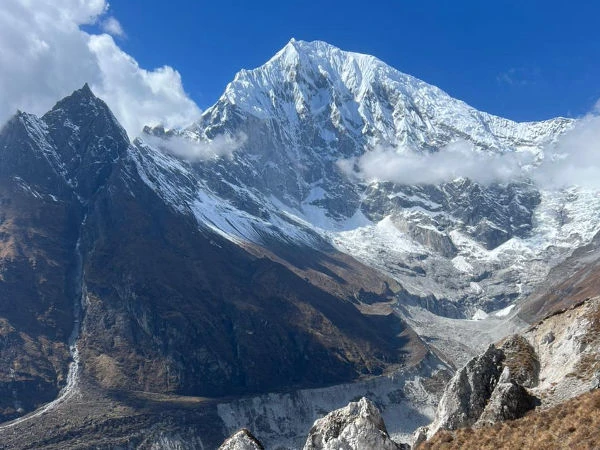Mount Everest, in all its awe and glory, has exhorted many individuals around the world to conquer it. Surprisingly though, the people who have been successful in surmounting the highest peak of the world are quite numbered. Having said that, the journey to the base camp of the highest peak in the world is no ordinary feat and requires a person to acquire a robust mix of fitness, dexterity, and determination.
For the avid wanderlust souls, the trek to the Everest Base Camp (EBC) is relatively less onerous and almost as fulfilling. Entrenched among the magisterial kingdom of the Himalayas, EBC is located at an altitude of 5364 m above sea level. The exhilarating trek commences at Lukla and is set to render an enthralling panoramic view of Mt. Everest (8848 m), Mt. Lhotse (8414 m) and Mt. Cho Oyu(8188 m) along with other prodigious mountains from the Khumbu region. The trekkers also get an opportunity to set foot into the revered Sagarmatha National Park which houses a wide species of flora and fauna. The most prominent feature of the EBC Trek is the viewpoint from Kala Patthar which allows the trekkers to rejoice the picturesque aesthetic of Mt. Everest and numerous other peaks in the Everest region. In addition to the comely environment, the villages in Namche Bazaar, Tengboche, Dingboche, Pheriche and Phortse are marked by cultural richness and provide the outsiders, a peek into the traditions and lifestyles of the native Sherpas. The trail to EBC also endows Buddhist monasteries and stupas embellished with colorful prayer flags that sway to the tunes of the frigid mountain air.
The entire trek to EBC consists of two altitude regions aptly regarded as “high altitude” (2500 m – 3500 m) and “very high altitude” (3500 – 5500 m) zones. Ascending to such heightened elevation may cause High Altitude Illness (HAI). The major causative factor of HAI is the drop in the barometric pressure which leads to the dwindling concentration in the oxygen levels of the atmosphere. This, in turn, results in a lowered oxygen level in a trekker’s bloodstream. Traveling to high altitudes may also aggravate certain antecedent medical conditions.
The prime cause of the High-Altitude Sickness is the diminishing availability of oxygen level in the atmosphere with increasing elevation. While the percentage atmospheric composition of oxygen remains constant (21 %), the density of the atmosphere plummets and the available oxygen becomes less. The decrease in density is not linear and it shrinks more rapidly with increasing altitude meaning that the impact from 10,000 to 20,000 feet might not be as consequential as ascending from 20,000 to 30,000 feet.
The towering elevation is known for its maladies such as Acute Mountain Sickness (AMS), High Altitude Cerebral Edema (HACE) and High-Altitude Pulmonary Edema (HAPE). It is thus, very crucial to gain a vivid understanding of the symptoms and remedies of these conditions to ensure one’s safety. Trekkers must be well acquainted with the term acclimatization. It is a process by which the body adapts to the conditions of high altitudes, such as lower levels of oxygen and decreasing air pressure. This is done by spending time at the higher elevations, making the process gradual and steady with ample preparations for the journey ahead.
High Altitude sickness can be pigeonholed into three major types:
1. Acute Mountain Sickness (AMS)
The most common of it all is the Acute Mountain Sickness (AMS) which is a medical condition where one part of the balance-sensing system (inner ears, eyes, and sensory nerves) senses that the body is moving but the other parts remain stagnant. Symptoms usually occur within 6 to 12 hours of arrival at altitudes above 2400 m.
2. High Altitude Pulmonary Edema (HAPE)
High Altitude Pulmonary Edema (HAPE) is an embryonic fatal condition in which the lung capillaries leak leading to the accumulation of fluids in the lungs. This results in adverse implications such as difficulty in absorbing oxygen into the blood. HAPE is quite rare, nonetheless can occur in people who rapidly ascend to altitudes above 2500 m.
3. High Altitude Cerebral Edema (HACE)
High Altitude Cerebral Edema (HACE) is an atypical life-threatening altitude disease and is an extreme form of Acute Mountain Sickness (AMS). This severe condition occurs when pressure built up in the brain causes fluid to breach the capillary walls in the cranium. It is usually seen among the Mountaineers traveling at a much higher elevation than EBC, such as those set out to reach to the roof the world.
Symptoms of Altitude Sickness.
Signs and indications of altitude sickness tend to spring up at around 3,000m for most individuals. The most customary reason for individuals experiencing the symptoms is usually due to fast ascents in high altitudes. Overexertion and dehydration will further increase the chance of being victim to altitude sickness, therefore making gradual ascent is of utmost primacy.
Level 1: Mild Altitude Sickness
- Headaches
- Fatigue
- Nausea
- Shortness of breath
- Dizziness
- Loss of appetite
Level 2: Moderate Altitude Sickness
- Severe headaches (migraines)
- Strong nausea/ heavy vomiting
- Intense fatigue/muscle weakness and cramps
- Difficulty in breathing
- Ataxia (lack of coordination)
Level 3: Severe Altitude Sickness
- Inability to walk
- Severe shortness of breath
- Poor cognitive abilities
- Rapid hallucinations
- Fluid build-up and swelling in the lung cavity
Related Blog.
How to Prepare for the Everest Base Camp Trek
Mt. Everest Base Camp Trek for Beginners
Prevention and treatment of Altitude Sickness.
1. Carry out a preliminary research.
The most essential step to take before commencing any trek is to do a thorough preliminary research about the topography, elevation, people, possible dangers, local weather patterns, map study and other physical features of the desired destination. This will allow you to mentally and physically prepare yourself to take on any challenges along arduous journey ahead of you. Most of the trekkers underestimate the trek to EBC and overlook the dire snares of the journey. Although considered to be a moderate trek, the trail leading up to EBC has varying oxygen levels at different points, which is a matter of serious consideration. The trekkers must be well prepared to defend themselves during periods of unpredictable weather conditions and snowstorms.
2. Slow and steady is the way to go.
Most of the trekkers become victims of altitude sickness when they ascend in a hasty manner and try to reach the destination as quick as possible. When the individual walks at an accelerated pace, his/her body becomes restive and skittish. This will impede the body to adapt to the low oxygen levels and result in dehydration.
3. Climb high during daylight and sleep at lower altitudes.
There is a high amount of chance that the trekker will experience altitude sickness while sleeping or after he/she wakes up from the sleep. Thus, this effect can be ameliorated if one climbs up to a higher altitude during daytime and then descends down to a lower altitude to get sleep. After an elevation of 3000 meters is reached, it is best to assert the sleep elevation below 300 meters each day.
4. Muster up your strength beforehand.
Altitude sickness most commonly occurs in individuals who have weak physique and stamina coupled with a medical condition. However, altitude sickness is not restricted to a specific age group and even a regular healthy person can fall prey to the condition. So, it is highly imperative to undergo a rigorous physical training and carry out a regular workout session for an allocated period of time looking at one’s physical strength. Physical exercises such as cardio training, running and walking are very much encouraged.
5. Hydration is the key!
The cool environment of the mountainous surroundings will often make you less thirsty. However, this will result in a dehydrated body and will make you lethargic and quickly tired. Medical experts have suggested that drinking up to 5 liters of water daily is essential to sustain the normal body conditions in most of the trekking events. Also, alcohol consumption and smoking are discouraged during the trek as it will affect the metabolic rates of the person and further cause to experience difficulty in breathing due to low oxygen levels.
6. Medications to the rescue.
It is very crucial to take medicines like Diamox (Acetazolamide) with the right dosage at the right time, which will suppress altitude sickness to a certain degree and assist the acclimatization process. If you have a pre-existing medical condition, you must consult with your physician for further medications.
7. Better to be safe than sorry.
Majority of the travel and trekking insurance cover only up to 2000 m. But to be ensured whole-heartedly, it is strongly recommended to get trekking insurance for EBC that covers you up to 6000 m that will cover all the expenses relating to any injury or illness on the journey.
8. Honesty is the best policy.
If you have even the slightest inkling of the symptoms of Altitude Sickness, you must resort to taking medicine. You should immediately focus your attention on adopting the preventive measures and informing your team. Lying about your condition and dodging the sickness will definitely worsen the situation for everyone.
Finally,
All in all, the Everest Base Camp (EBC) has a distinctive aura, which strikingly allures trekkers to have an experience of a lifetime. With the chance to fully immerse in the Himalayan escapade, undertake a rip-roaring trail and encounter the Sherpa culture, your search for the ultimate daredevil adventure ends here. While the paths less traveled may seem nebulous and offer the likes of altitude sickness, one must gear up for the worst possible scenario. Like any other trek, EBC will most definitely bestow the tricks hidden upon its sleeve, but after proper planning, one can embark on this thrilling journey with much ease.





